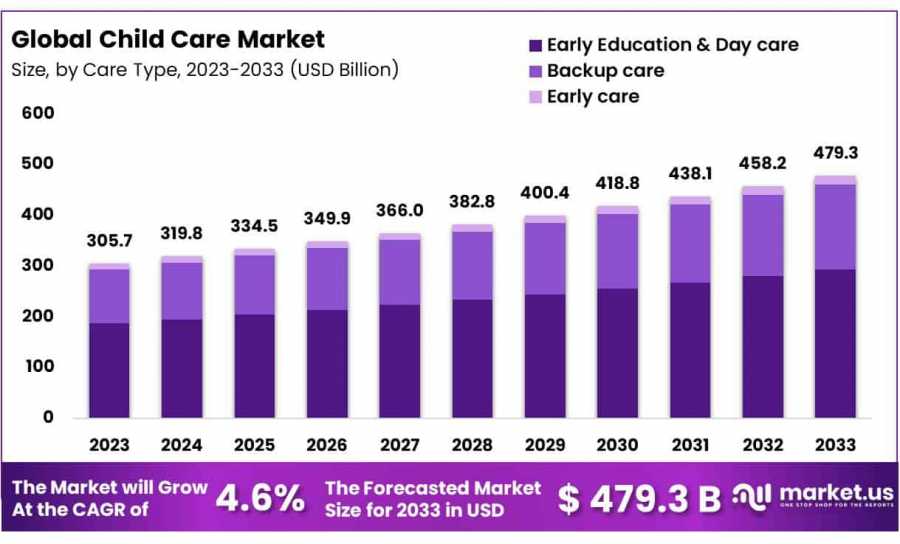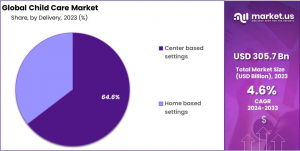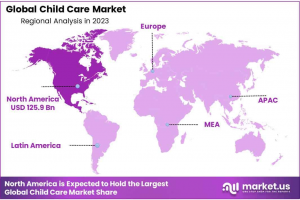
Child Care Market To Grow at 4.6% CAGR, Reaching USD 479.3 Billion By 2033 | Segmented By Care Type, By Delivery
Global Child Care Market size is expected to be worth around USD 479.3 Billion by 2033 from USD 305.7 Billion in 2023, growing at a CAGR of 4.6%
NEW YORK CITY, NY, UNITED STATES, January 27, 2025 /EINPresswire.com/ -- Report Overview
Global Child Care Market size is expected to be worth around USD 479.3 Billion by 2033 from USD 305.7 Billion in 2023, growing at a CAGR of 4.6% during the forecast period from 2024 to 2033. In 2023, North America led the market, achieving over 41.2% share with a revenue of US$ 125.9 Billion.
Key factors contributing to this expansion include government initiatives supporting child care services, higher household incomes, and growing demand for structured learning environments. The market comprises various segments, including daycare services, early education programs, and in-home care services. Technological advancements, such as digital learning platforms and monitoring tools, are reshaping the child care landscape by enhancing transparency and communication between caregivers and parents. Additionally, the emphasis on child safety, skill development, and social interaction is fueling the adoption of professional child care services.
Regionally, North America dominates the market due to its established infrastructure, while Asia-Pacific is emerging as a lucrative region, driven by urbanization and increasing working-class populations. Major players, including Bright Horizons Family Solutions and KinderCare Education, are focusing on service expansion and innovation. As demand for quality child care continues to grow, the market is poised for sustained development, benefiting children, parents, and service providers alike.
Unlock Competitive Advantages With Our PDF Sample Report@ https://market.us/report/child-care-market/request-sample/
Key Takeaways
• Market Size: The global child care market is projected to reach USD 479.3 billion by 2033, up from USD 305.7 billion in 2023.
• Market Growth: The market is expected to grow at a compound annual growth rate (CAGR) of 4.6% between 2024 and 2033.
• Care Type Analysis: The early education and daycare segment held a significant revenue share of 61.2% in 2023, reflecting its strong market position.
• Delivery Analysis: Center-based care dominates the market, contributing an impressive 64.6% of revenue share.
• Regional Analysis: North America leads the global child care market, capturing 41.2% of the market share in 2023.
• Technological Integration: Increasing adoption of technology, such as management software for administrative tasks and educational tools to enhance learning, is a notable trend.
• Competitive Landscape: The market is highly competitive, featuring a mix of independent providers and large chains, with service quality, location, and pricing being key differentiators.
How Artificial Intelligence (AI) is Changing the Child Care Market?
• Enhanced Safety Measures: AI-powered facial recognition systems and advanced monitoring tools are being adopted in child care centers to improve security. These technologies ensure authorized access, track attendance, and provide real-time surveillance to enhance child safety.
• Personalized Learning: AI-based educational platforms are enabling customized learning experiences for children. By analyzing individual learning patterns, these systems tailor activities and lessons to each child's pace and preferences, fostering better engagement and development.
• Streamlined Operations: AI-driven management software is automating administrative tasks such as scheduling, billing, and communication with parents. This allows caregivers to focus more on child care rather than administrative duties.
• Parent-Caregiver Communication: AI-integrated apps provide real-time updates to parents about their child’s activities, meals, and progress. This transparency builds trust and strengthens the relationship between parents and caregivers.
• Behavioral Insights: AI systems can track and analyze children’s behavior, identifying patterns that may indicate developmental issues. This enables early intervention and tailored support for children’s growth.
Market Segments
By Care Type
• Backup Care
• Early Care
• Early Education Care
• Daycare
By Delivery
• Home Based Settings
• Centre Care Settings
Market Dynamics
• Driver: The increasing participation of women in the workforce has significantly driven the demand for child care services. As more mothers engage in employment, the need for reliable child care solutions has become essential to support their professional commitments. This trend underscores the critical role of child care in enabling parents, particularly mothers, to maintain and advance their careers.
• Trend: The COVID-19 pandemic has highlighted the essential nature of child care services, leading to increased recognition of their importance in economic recovery. This period has seen a shift towards more flexible and diverse child care arrangements, including the rise of in-home care and family child care networks, to accommodate varying family needs and health considerations.
• Restraint: The child care industry faces significant challenges due to low wages and high turnover among early childhood educators. Despite the critical nature of their work, many child care workers earn wages that are insufficient to meet basic living expenses, leading to economic insecurity and reliance on public assistance programs. This situation contributes to high turnover rates, which can negatively impact the quality and stability of child care services.
• Opportunity: Government initiatives to subsidize child care present a significant opportunity to enhance access and affordability for families. For instance, studies have shown that government-subsidized child care can positively impact women's employment outcomes and firm performance. By investing in affordable child care solutions, policymakers can support workforce participation and promote economic growth.
Buy This Premium Research Report@ https://market.us/purchase-report/?report_id=117305
Recent Developments in Child Care
The child care sector has seen notable changes in recent years, particularly in response to the COVID-19 pandemic. A January 2023 report from the U.S. Department of Health and Human Services highlighted that, as of November 2022, child care employment had not yet returned to pre-pandemic levels, with significant variation across states. While the number of child care programs increased, the average number of employees per program decreased. Additionally, average hourly earnings for child care workers were higher in August 2022 compared to pre-pandemic levels, due to increases in non-supervisory workers’ earnings.
In California, the Department of Education was awarded a federal Preschool Development Birth Through Five Initial Grant of over $10 million from the U.S. Department of Health and Human Services’ Administration for Children and Families. This grant aims to enhance early childhood education programs across the state.
The Administration for Children and Families (ACF) has been actively involved in child care research and evaluation projects. Their efforts focus on understanding the efficacy of child care subsidy policies and programs in enhancing employment and economic self-sufficiency of low-income families, as well as improving quality in child care and early education settings to support learning and development of children from birth through age 13.
The Centers for Disease Control and Prevention (CDC) has developed resources to support early care and education programs. These resources assist educators in tracking and celebrating each child's developmental milestones, communicating with parents about development, and providing guidance on discussing developmental concerns. The aim is to aid in early identification of developmental delays or disabilities, ensuring timely intervention.
Top Key Players
• Bright Horizons Family Solutions, Inc.
• KinderCare Education
• Learning Care Group, Inc.
• Cadence Education
• Goodstart Early Learning
• Spring Education Group
• Primrose School Franchising SPE, LLC.
• G8 Education, ltd.
• Kitty International School & Preschool
• Klay.co.in
Emerging Trends in Child Care
1. Incorporating Nature into Learning: There's a growing movement to integrate nature into early childhood education. Approaches like 'Forest Schools' from Scandinavia are influencing North American practices. Educators are emphasizing outdoor activities, allowing children to explore and learn in natural settings. This method enhances motor skills and fosters a connection to the environment. Even in urban areas, teachers are introducing natural elements into classrooms or dedicating time for outdoor exploration. This trend reflects a broader recognition of the benefits of nature-based learning in child development.
2. Emphasis on Phonics in Literacy: A renewed focus on explicit phonics instruction is emerging in early childhood education. Experts highlight the importance of systematic phonics to improve literacy. Educators are encouraged to develop strong skills in teaching phonics, as this approach has been shown to enhance reading abilities in young children. This shift addresses previous gaps in literacy curricula and aims to provide a solid foundation for reading success.
3. Addressing the Achievement Gap: Efforts to close the achievement gap among different socioeconomic groups are gaining momentum. The Every Student Succeeds Act (ESSA) allows states to assess early childhood education needs and request federal grants. These funds support programs aimed at improving literacy and academic skills, particularly for disadvantaged students. This initiative seeks to ensure all children, regardless of background, have access to quality education from an early age.
4. Integrating Technology in Education: The use of technology in early childhood classrooms is expanding. Educators are incorporating digital tools to enhance learning experiences, balancing screen time with traditional activities. This integration aims to prepare children for a technologically advanced society while supporting various aspects of their development. The challenge lies in using technology intentionally to support learning goals without overshadowing essential hands-on experiences.
Use Cases in Child Care
1. Parental Care Dominance: A significant number of parents opt to care for their children themselves. Data indicates that about 35% of households with young children and incomes below $75,000 provide care without external assistance. This choice often stems from financial considerations or a desire for direct involvement in early development. However, it can impact parents' ability to engage in full-time employment.
2. Reliance on Relatives for Child Care: Many families depend on relatives for child care support. Approximately 21.8% of parents report that their children are cared for by relatives other than the parents. This arrangement offers a trusted and cost-effective solution, providing children with familiar caregivers and maintaining family bonds. It also offers flexibility that formal child care centers might not provide.
3. Utilization of Day Care Centers: Day care centers serve as a primary child care option for many families. Around 8.4% of parents utilize these centers, which offer structured environments, socialization opportunities, and educational activities. Day care centers are particularly beneficial for working parents seeking reliable and consistent care schedules. They also provide children with a chance to interact with peers, supporting social development.
4. Impact of Child Care Costs on Employment: High child care costs influence parents' employment decisions. In households earning less than $75,000 annually, about 35% reduce work hours or leave jobs to manage child care responsibilities. This reduction can lead to financial strain and affect career progression. Addressing child care affordability is crucial to support working families and economic stability.
Lawrence John
Prudour
+91 91308 55334
Lawrence@prudour.com
Distribution channels: Healthcare & Pharmaceuticals Industry
Legal Disclaimer:
EIN Presswire provides this news content "as is" without warranty of any kind. We do not accept any responsibility or liability for the accuracy, content, images, videos, licenses, completeness, legality, or reliability of the information contained in this article. If you have any complaints or copyright issues related to this article, kindly contact the author above.
Submit your press release


